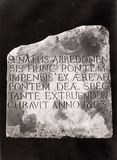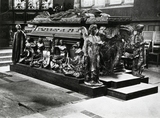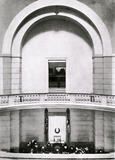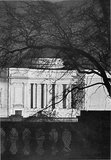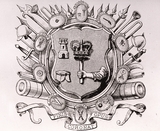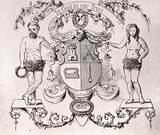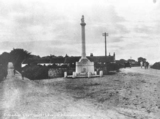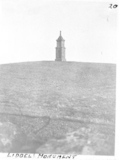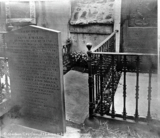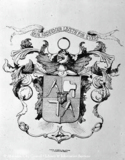|
Quick Search
|
Search Results
You searched for: Subject matches "Memorials and Inscriptions" or its children
80 items
items as
Latin inscription, Ruthrieston Bridge
59 Latin inscription on stone, Ruthrieston Bridge. It reads "Senatus Abredonensis hunc pontem impensis ex aere ad pontem deae spectante extruendum curavit anno 1693" ("The Town Council of Aberdeen caused this bridge to be built with moneys from the Bridge of Dee Fund in the year 1693"). Allenvale Cemetery from Kincorth
60 An early photograph of Allenvale Cemetery, taking shape in the middle distance, as seen from Kincorth, with Abbotswell Farm in the foreground.
A limited company called the Aberdeen Cemetery Company was established for the purpose of creating this new graveyard. A prospectus inviting public investment was published in the Aberdeen Journal of 29th January 1873. It reads as follows:
"It is well known that in Aberdeen cemetery accommodation is limited and insufficient, and it is generally admitted that its extension is necessary, and cannot much longer be delayed. It is therefore desirable to acquire additional space for that purpose, and to treat it in accordance with modern ideas and practice.
"This company has been formed for the purpose of providing an extensive Cemetery, in the neighbourhood of Aberdeen, suitable in all respects for the purposes of internment, and of easy access - but sufficiently removed from town to preserve its suburban character."
The new cemetery opened in late 1874 and, as we know, was a big hit. It was officially known as the Aberdeen Cemetery but quickly became known as Allenvale Cemetery, after the property on which it was built.
Allenvale saw major extensions in 1912 and 1932. A London syndicate purchased control of the graveyard from the Aberdeen Cemetery Company in 1958. Aberdeen Town Council subsequently took control of the cemetery in 1965 following the then owners going into liquidation and worries about Allenvale's future. Allenvale remains a fine example of a planned Victorian cemetery to this day.
Notable residents of Allenvale include John James Rickard MacLeod (1876-1935), co-discoverer of insulin, James Scott Skinner (1843-1927), fiddler and composer, and Mary Esslemont (1891-1984), the influential doctor. Though, of course, many interned at Allenvale would have their own interesting stories to tell.
In this photograph, Duthie Park, later created on the right, has yet to be landscaped. St. Machar Poorhouse, Fonthill House and Devanha House can all be seen in the distance. The Cowdray Hall War Memorial
122 The Cowdray Hall, War Memorial and Art Gallery taken from Union Terrace Gardens. The Hall was opened by King George V and Queen Mary on 29th September 1925. Tomb of Bishop Gavin Dunbar
195 The tomb of Bishop Gavin Dunbar at St. Machar's Cathedral, Aberdeen.
Gavin Dunbar was appointed Bishop of Aberdeen on 5th November 1518 and died on 9th March 1532. He became a great benefactor not only of King's College, but of the town.
It was he who took over the plans left after the death of Bishop Elphinstone and created the Bridge of Dee which opened road access to the City, from the south.
Dunbar also built the twin towers at St. Machar's Cathedral and gave its magnificent ceiling at his own expense. It comprises 48 heraldic shields including the arms of Scottish monarchs, nobles, Kings of Europe, and Scottish Bishops.
When he died in 1532, he was buried in the south transept of the cathedral. This was virtually destroyed after the collapse of the great central tower in 1688, and a recumbent statue of white marble of Dunbar was broken into pieces during the Reformation.
The splendor of the six foot richly carved arch of Morayshire freestone is still obvious despite its exposure to the weather. A bishop's mitre surmounts the Dunbar coat of arms and his initials, at the right hand side. Tomb of Bishop William Elphinstone
197 The tomb of Bishop William Elphinstone in King's College Chapel, Old Aberdeen. The bronze and marble monument was designed by Henry Wilson and it is seen here within the Chapel in the 1920's. Due to issues with its size, the monument was eventually relocated to a site outside the Chapel in 1946. Cowdray Hall, 1927
218 Shrine, war memorial, Cowdray Hall, 1927.
The War Memorial and the extension of the Art Gallery, including the Cowdray Hall and Museum, were opened by King George V and Queen Mary on 29th September 1925.
These were erected at a cost of 80,000 pounds, with the cost of the War Memorial being raised by public subscription.
The War Memorial is a cenotaph, in the form of a Memorial Court or Hall of Remembrance and is "consecrated to the memory of those 5000 of the city and district who gave their lives on land and sea 'that we might live'".
The shrine is of white and grey marble in a niche in the north wall of the Memorial Court, directly opposite the entrance. It takes the form of a table on which is placed the Roll of Honour, printed on vellum, within glass.
The table is supported by trusses decorated in Renaissance style. On either side are the Union Jack and White Ensign, representing Army and Navy, and in the centre is a laurel wreath in gilt bronze.
Also in the picture can be seen the circular balcony or gallery, with a graceful balustrade, grey marble coping and ornate mouldings, which encircles the Court and leads to various picture galleries, one of which can be seen through the doorway War memorial at Cowdray Hall
219 War memorial at Cowdray Hall. The War Memorial and the extension of the Art Gallery, including the Cowdray Hall and Museum, were opened by King George V and Queen Mary on 29th September 1925. These were erected at a cost of £80,000, with the cost of the War Memorial being raised by public subscription. The War Memorial is a cenotaph, in the form of a Memorial Court or Hall of Remembrance and is "consecrated to the memory of those 5000 of the city and district who gave their lives on land and sea 'that we might live'". Arms of Hammermen tradesmen's guild
295 Arms of Hammermen tradesmen's guild, with motto "Finis coronat opus" - Hammermen are one of the seven Incorporated Trades of Aberdeen Arms of the Shoemakers' tradesmen's guild
296 Arms of the Shoemakers' tradesmen's guild, with motto "Lord crown us with glory" - Shoemakers are one of the seven Incorporated Trades of Aberdeen The Fleshers' Armorial Bearings
297 The Fleshers' Armorial Bearings, with motto "Virtute vivo" - Fleshers are one of the seven Incorporated Trades of Aberdeen Arms of the tailors' tradesmen's guild
300 Arms of the tailors' tradesmen's guild, with motto "In God is our trust", dated 1682 - Tailors are one of the seven Incorporated Trades of Aberdeen Arms of the bakers' tradesmen's guild
301 Arms of the bakers' tradesmen's guild, with motto "Floreant pistores, panis nil saturat, Deus ni benedicat" - Bakers are one of the seven Incorporated Trades of Aberdeen Monument to Dr William Guild
307 Monument in St. Nicholas Church graveyard to Dr William Guild, Incorporated Trades. Tomb of Bishop Gavin Dunbar
469 The tomb of Bishop Gavin Dunbar in the ruined South transept of St. Machar's Cathedral, Old Aberdeen. The carved stone effigy has since been moved inside the Cathedral. Provost Cruickshank's coat of arms on Ruthrieston Pack Bridge
521 Provost Robert Cruickshank's coat of arms on Ruthrieston Pack Bridge, which he had installed without being first sanctioned by the City Council. He refused to remove it and the Master of Bridgeworks turned the panel over and had engraved a Latin inscription recording that the bridge was erected out of funds mortified for the upkeep of the Bridge of Dee. By 1705 the stone was again reversed and Cruickshank's coat of arms was visible again. Culter War Memorial
994 A photograph showing the unveiling of a new panel at Culter War Memorial on Sunday 19th June 1949.
The article 'Tribute to War Dead of Culter' from the Press & Journal of 20th June 1949, page 6, describes the ceremony as follows:
"A panel containing the names of 29 men from the parish who lost their lives in the recent war was unveiled at Culter War Memorial yesterday.
"Relatives of the fallen and representatives of the Boys' Brigade, Girl Guides, Brownies, and the Territorial Army were grouped round the memorial as Mrs Tough, Hillside Road, Culter, who lost two sons in the war, unveiled the tablet.
"The panel was dedicated by the Rev. J. R. Dey, Kelman Memorial Church, who, along with the Rev. T. W. Howie, St Peter's Church, conducted the service"
Culter War Memorial is a tapering, crenelated tower located on a hillock to the west of the village. It is accessed by a footpath that leaves North Deeside Road not far beyond the bridge over the Culter Burn.
Correspondent Brian Coutts has been in touch to inform us that one of the representatives of the Brownies present at the ceremony was Elizabeth McNab.
The abovementioned sons of Mrs Jane Tough of Hillside Road were Driver Frank Tough, Royal Corps of Signals, formerly an employee of Culter Paper Mills, who was killed by enemy action in the Middle East on 24th September 1942, aged 24, and Private Ernest "Ernie" Tough, 2nd Gordons, who died on 5th October 1943, aged 26, while a prisoner-of-war in Thailand. (Source: Press & Journal, 26th September 1946, page 3.)
The former, Frank Tough, is buried at Alexandria (Hadra) War Memorial in Egypt and Ernest is buried Thanbyuzayat War Cemetery in Myanmar. (Source: Commonwealth War Graves Commission website.) Tomb of Bishop Gavin Dunbar
1251 The tomb of Bishop Gavin Dunbar in the ruined South transept of St. Machar's Cathedral, Old Aberdeen. The carved stone effigy has since been moved inside the Cathedral. Memorial to Ann Allardyce
1290 Memorial to Ann Allardyce in the West Church of St. Nicholas. The inscription reads, "Sacred to the memory of Ann the wife of Alexander Allardyce of Dunnottar and daughter of Alexander Baxter of Glassel. She was married the 7 August 1786, gave birth to her son Alex Baxter Allardyce the 28th of July and departed this life at Aberdeen the 1st of August 1787 aged 28 years. As a tribute justly due to the Eminent Virtues, Gentle Manners and Personal Accomplishments of a most amiable Woman her disconsolate husband dedicates this monument". John Bacon, London, sculptor 1791. Liddel Monument
1735 Liddel Monument (1637). Erected to the memory of Duncan Lidell (1561 - 1613), Rector of the Julian University in Rome and physician to the court of Brunswick. The Arms of Wrights and Coopers
1920 The Arms of Wrights and Coopers, granted in 1696, with motto "Our Redeemer liveth for ever". They are one of the Seven Incorporated Trades of Aberdeen. |



